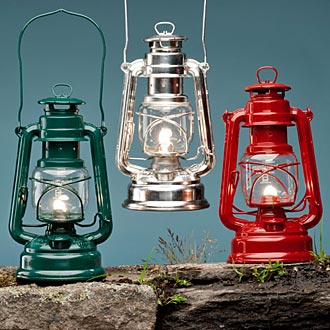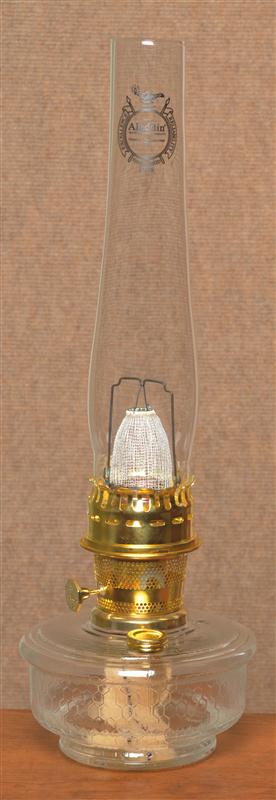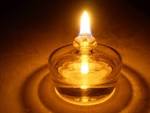

(Tubular) Hurricane lantern Oil Lamp
This page was created to demonstrate the benefits and deficiencies in using oil lamps versus light emitting diode technology for grid-down scenarios. Also expanding on this to provide for normal grid-up usage.
First, I will tell you why I came up with this analysis. I am often asked to obtain and demonstrate the uses of kerosene or oil lamps. It seems like this is the first thing someone needs if the power goes out in their home. Over the years I too, had purchased a number of these oil lamps and have them ready to use around my house because I have experienced many power failures in our rural neighborhood. Oil lamps are readily available in most stores such as Walmart or hardware stores, and available online. Oil lamps typically burn purified (or paraffin) lamp oil or K1 kerosene. They come in all sizes and shapes but fall into one of two major categories. (Tubular) hurricane lanterns and tabletop oil lamps.


(Tubular) Hurricane lantern Oil Lamp
There are other types like the high end Aladdin lamps ($150 to $300) that give off a very bright white light, or simple wick type bowls.


Aladdin lamp Simple Oil lamp
There are different widths of wicks for different size lamps. Typically 3/8 inches or 7/8 inches wide. The cotton wick dips into the oil and it "wicks" up to the combustion point. It is necessary to trim the wicks every so often to insure correct combustion. Impurities and unburned oil cause a black crust to form on the top of the wick that needs to be removed from time to time otherwise there will be smoke and reduced light. So it is important to have spare wicks on hand. It is necessary to adjust the flame so it is bright enough but not so bright that it emits unnecessary black smoke. It is also necessary to burn only fresh oil. Oil that has set in the lamp for a number of years should not be used. It has lost much of its volatile compounds. Yes, it will work but it may be hard to light, smokes a lot, smells bad, and won't give adequate light.
After researching and demonstrating oil lamps to others, I have come up with an important conclusion. Before I show my findings I will explain an alternative.
LED's or Light Emitting Diodes have come a long way and the technology hasn't stopped in improving their performance. You see LED's in almost every piece of electronic equipment today. They are in cell phones, radios, TV's, computers, flashlights, streetlights, Christmas lights, displays, entertainment equipment, auto dash boards and headlights, etc. LED's come in all sizes, shapes, and colors. For many years they were typically red. Then green ones were developed. After that, yellow and blue came out, then white. A typical LED looks like this:

They were first used on front panels of electronic equipment. The biggest drawback to these LED's was the amount of usable light output. As the technology improved, so did the amount of light. Today, 2018, LED's have replaced tungsten filament and compact fluorescent bulbs and taken over the house light bulb market. Early ones were somewhat dim or too "blue-white" looking. Today the output color looks more like a typical tungsten filament color. Technically referred to as a "color temperature" of 3000 degrees K.
Because LED's come in so many styles, shapes and configurations, the final product can take on many forms depending on the designer. A simple LED light can go head to head with an oil lamp and win out every time.
Now for my analysis and opinion for a single oil lamp versus an LED light configuration:
| Oil Lamp | LED light | |
| Cost | $8.00 for lamp, $7.00 per liter of lamp oil. Wicks and matches will be needed. | $23 for a typical LED lamp, $9.00 for a box of quality alkaline batteries for the same burn time of a liter of oil. |
| Reliability | Questionable | Robust |
| Danger/safety | Accidentally dropping or spilling an oil lamp could easily burn a house down in no time. | Completely safe |
| Light output | 100% | 100% |
| Environment | Petroleum distillates emit noxious fumes. Hard to clean walls and ceilings | 100% safe |
| Long term storage | Year or so oil quality | Shelf life of batteries |
| Durability | Fragile | Rugged |
Oil lamps are dangerous, give off an odor that many with respiratory ailments can't tolerate or are allergic to. You may have seen old movies or TV shows where an oil lamp drops on ground and ignites everything around in an instant. This is what actually happens. You only have moments to extinguish the flame or your house may completely burn down. LED lamps are simple, reliable, safe, child proof, and predictable.
With an LED system you can also expand it and increase performance to achieve a normal lifestyle. I will demonstrate a more enhanced system that may replace your conventional home lighting. As always with new technology and new designs with solar and charging systems, the initial cost may be a little high but in the long run as you add to your system the price and usage will be very desirable.
This project is primarily designed for a grid-down scenario but as the design morphs into a larger system it can provide all the necessary light in your house.
The system described here derives its power from the sun. The power is stored in a rechargeable battery. The lights can be configured to provide any intensity from a nightlight to a full 100 watt equivalent light source and can be installed in as many rooms as you desire. Since the system is a low voltage system, 12 volts, you aren't bound by electrical code compliance as long as safety precautions and good construction techniques are followed. This system can be expanded to as much light as you need but for the purpose of this initial system it is designed for one or two rooms. The nice thing about this system is that it is not connected to your house wiring. It will run indefinitely without maintenance.
First, we need to do a little math. We will use "watts" as our common reference. We need to calculate the power generation, power losses, and power consumption in order to assure there is sufficient light throughout at least one night.
We will start with a simple solar panel that generates about 15 watts at 18 volts. We will estimate the panel will receive about four hours of light a day. If you multiply 15 times 4 you get 60 watt/hours. In theory you can draw 60 watts for one hour. In reality there are losses in the charging circuit, losses in the self discharge of the storage battery. As an average you can probably figure a 15% system loss. So you can figure about 45 usable watts. If you had an LED light system that drew about 8 watts, you could draw power for 6 hours. If the solar panel was oriented correctly (primarily south) and you had a good 8 hours of daylight, you could store almost 120 watts of energy. If you had an overcast day you might only store about 25 watts or so. A battery with a larger capacity will allow you to have ample light during a week or so of overcast days.
Let's say you came home and turned on a light in the bedroom and family room and kitchen. On a typical day of the year it was turned on at 6 PM and you turned it off at 11 PM. If you used a typical 60 watt equivalent LED lamp that draws around 7.5 watts, you get 7.5 (bulb draw) X 3 (rooms) X 5 (hours) = 112.5 watts consumption. This would require a solar panel output of about 50 watts. That would put about 200 watts of charge into your battery system. More than enough to light three rooms for five hours. Obviously if you economized and turned the lights off that were not needed, you could extend the usage of the battery for other lights or compensate for an overcast day.
So you can see, there are many variables that come into play. The best thing is to have enough solar power to fully charge the battery, add a bigger battery capacity, and configure your light usage to get the best performance.
With a good charge controller used to protect the battery from overcharge and ample solar output, let's say a 200 watt panel, you could almost power all the lights in your house. The goal here is to provide permanent lighting without any help from the main house wiring.
As of this writing, solar panel prices have dropped to almost $1 a watt. A 200 watt panel, a deep cycle 12 volt trolling battery or two, a good charge controller and you have the making of all the power needed to light up your house.
As you can see, there can be many configurations to achieve your needs. The intent of this page is to show how to build a lighting system for a grid-down scenario but it can be expanded to normal day to day usage. An added bonus is using a cigarette lighter type USB charger to keep your cell phones charged up should the AC house power ceases.
So here's a typical configuration for a high capacity power source.
$200.00 - 200 watt 12 volt panel (a panel from 50 to 200 watts will suffice)
$18.00 - Charge controller (required to prevent overcharging the battery)
$120.00 - 12 volt deep cycle trolling battery (available from Walmart auto
center)
$45.00 - Monitor and Distribution panel (custom built for each application)
$6.00 - custom light switch (multi intensity type)
$25.00 - custom light fixture
$3.00 - CAT5 cable
As time permits I will post pictures and drawings on how to implement the LED house. As of October 2018, it looks like standard lighting has changed from incandescent to compact fluorescent to LED type lighting. Standard 60 watt equivalent bulb prices have dropped to around US$1.00 in some discount stores.
©2018 RickC V 0.3 10/17/2018